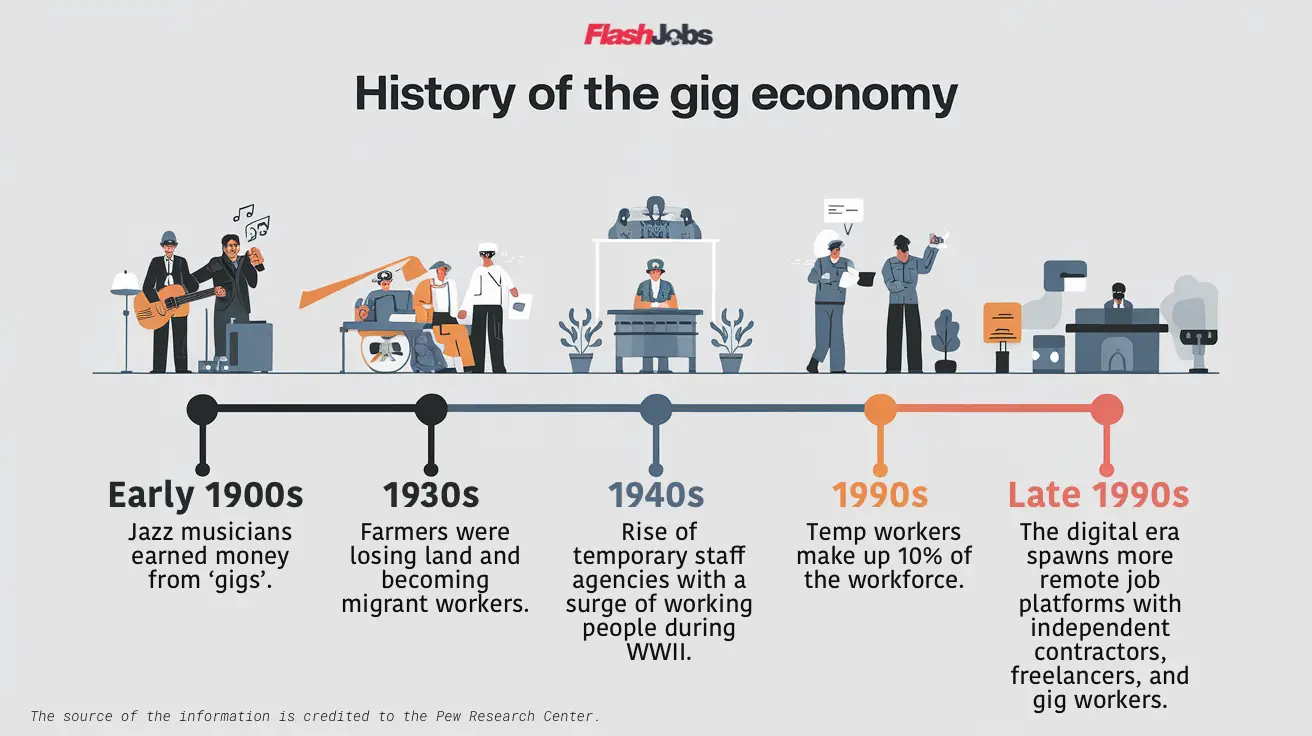Table of Contents
2025: The History and Evolution of Gig Economy – From Jazz Musicians to Digital Platforms
The history of the gig economy can be traced as back as the early 1900s. The gig economy has transformed the modern workforce, offering flexibility and diverse opportunities for millions of workers worldwide. From its humble beginnings to its current digital-driven state, the gig economy has evolved significantly over the past century. The gig economy now encompasses 16.4% of the American workforce, equating to 25-30 million gig workers.
This flexible work model has roots tracing back to the early 1900s, with temporary and contract work becoming more prevalent during economic shifts and wartime labor shortages. The late 20th century saw a surge in staffing agencies and freelance work, paving the way for today’s digital platforms that connect workers with clients globally.
The rise of online gig platforms has revolutionized how people find and perform work. Companies like Uber, Lyft, and DoorDash have created new opportunities for on-demand services, while freelance marketplaces enable professionals to offer their skills remotely. This digital transformation has reshaped traditional employment models and continues to impact the global labor market.
Key Takeaways
- The gig economy has grown from temporary work arrangements to a significant portion of the modern workforce.
- Digital platforms have revolutionized how gig workers connect with clients and perform services.
- The flexibility of gig work appeals to many, but it also presents challenges regarding job security and benefits.

1900s: Early Origins of Gig Work
The concept of gig work has roots stretching back to the early 20th century. Its emergence reflects changing labor dynamics and economic needs of the time.
How Did The Term ‘Gig Economy’ Originate?
The term “gig” originated in the jazz music scene of the 1920s. Musicians used it to describe their short-term performances or engagements. Jazz musicians coined “gig” to refer to one-night stands or temporary playing jobs. This terminology soon spread beyond music circles. It began to encompass various forms of temporary or freelance work across different industries. The concept resonated with workers seeking flexibility and diverse income sources.
However, the term “independent contractor” dates back to the early 1800s, with the earliest documented use appearing in 1838 in the Leicester Chronicle. The classification of independent contractors became more formalized in the early 20th century, particularly with the creation of the 1099 tax form in 1917. The concept gained significant legal and regulatory attention in the following decades, especially with the passage of key legislation like the National Labor Relations Act (1935) and the Fair Labor Standards Act (1938).
1930 to 1980s: Industrial Era Transformation
The period from 1930 to the 1980s saw significant shifts in labor patterns and economic structures. These changes were driven by major historical events and technological advancements.
The Migration Of Farmers Era Of The Great Depression
The Great Depression of the 1930s triggered a mass migration of farmers to urban areas. Many agricultural workers sought temporary jobs in cities as their farms failed. This influx of labor created a pool of workers willing to take on short-term or seasonal employment.
Urban factories and businesses began to rely more heavily on this flexible workforce. The concept of “day labor” became more prevalent, with workers lining up each morning hoping to be chosen for work.
During the Great Depression, gig work became a necessity for many. People took on multiple short-term jobs to make ends meet. This trend continued through World War II and beyond, as economic uncertainties persisted.
What Impact Did The Industrial Revolution Have On Temporary Labor?
The Industrial Revolution accelerated the trend towards temporary and flexible labor. Factories required workers who could adapt to changing production needs. This led to the rise of shift work and on-call labor practices.
New technologies also created demand for specialized skills. Companies began to hire temporary workers with specific expertise for short-term projects. This practice laid the groundwork for modern consulting and freelance work.
The war effort during World War II further reinforced these trends. Factories needed to rapidly scale up and down production, relying heavily on temporary workers.
Post-War Period Emergence Of Temporary Staffing Agencies
The post-war economic boom of the 1950s and 1960s saw the emergence of temporary staffing agencies. These agencies acted as intermediaries, connecting businesses with short-term workers.
Companies like Manpower and Kelly Services pioneered this model. They offered businesses flexibility while providing workers with a steady stream of temporary assignments.
By the 1970s and 1980s, temporary work had become a significant part of the labor market. It allowed companies to manage costs and adapt to economic fluctuations, and it provided workers with opportunities for diverse experiences and flexible schedules.
By the mid-20th century, temporary staffing agencies emerged. These organizations formalized the process of connecting workers with short-term employment opportunities, marking a significant step in the evolution of gig work.
Late 1990s to 2025: Digital Revolution & Emergence of Various Business Models
The digital revolution transformed the landscape of work, creating new opportunities and reshaping traditional employment models. This period saw rapid technological advancements that fundamentally altered how people find, perform, and manage work.
Key Developments: Early Days Of The Internet To 2025
– 1995: Craigslist launched as the first major digital platform for gig work
– 1998: Elance (now Upwork) emerged, pioneering online freelancing
– By 1995, alternative employment reached 10% of the American workforce
– 2005: Amazon Mechanical Turk created a marketplace for micro-tasks
– 2008: Airbnb transformed from an air mattress rental to a $75-billion platform
– 2010: Uber’s launch revolutionized transportation services
The late 1990s marked the beginning of widespread internet adoption. Websites and email became essential business tools, enabling remote work and global connectivity. By the early 2000s, social media platforms emerged, further expanding online networking capabilities. What also made it possible was opportunities for startups to innovate with different business models to cater to and solve specific market niches.
Cloud computing took off in the late 2000s, allowing for more flexible and scalable business operations. Artificial intelligence and machine learning gained traction in the 2010s, automating tasks and creating new job categories.
The COVID-19 pandemic in 2020 accelerated digital transformation across industries. Remote work became mainstream, and video conferencing and collaboration tools grew exponentially.
By 2025, 5G networks and Internet of Things (IoT) devices are expected to further blur the lines between physical and digital workspaces.
How Did The Rise Of The Internet Reshape Freelance Work?
The internet revolutionized freelancing by providing global access to job opportunities. Online job boards and freelance marketplaces emerged, connecting independent workers with clients worldwide.
Digital portfolios and personal websites allow freelancers to showcase their skills and attract potential employers. Remote collaboration tools enabled seamless communication and project management across time zones.
Payment platforms simplify international transactions, making it easier for freelancers to work with clients globally. The rise of e-learning platforms also allowed freelancers to continuously upskill and adapt to market demands.
Social media and professional networking sites became crucial for building personal brands and finding new clients. As a result, freelancing evolved from a niche option to a viable career path for millions.
What Role Did Smartphones Play In The Gig Economy’s Expansion?
Smartphones played a pivotal role in the gig economy’s growth by providing constant connectivity and on-the-go access to work opportunities. Mobile apps enabled real-time job matching and instant communication between workers and clients.
Location-based services allowed for hyper-local gig work, particularly in transportation and delivery sectors. The rise of Uber and similar ride-sharing apps exemplified this trend, creating a new category of gig work.
Mobile payment systems facilitated quick and easy transactions, essential for short-term gigs. Push notifications kept workers informed about available jobs, increasing responsiveness and flexibility.
Smartphone cameras and GPS enabled workers to document their work, track time, and navigate efficiently. The ability to manage multiple gig platforms simultaneously from a single device increased earning potential for many workers.
How Did Online Platforms Revolutionize The Gig Marketplace?
Online platforms transformed the gig economy by creating efficient marketplaces that match workers with tasks. These platforms use algorithms to optimize job assignments based on skills, location, and availability.
Rating systems and reviews introduced accountability and trust in the gig ecosystem. This allowed quality workers to build reputations and command higher rates.
Platforms like Airbnb disrupted traditional industries by enabling individuals to monetize their assets. This created new categories of gig work in hospitality and property management.
Specialized platforms emerged for various industries, from creative services to professional consulting. This diversification expanded the range of available gig work beyond manual labor and entry-level tasks.
Data analytics provided insights into market trends and worker performance, allowing the gig ecosystem to be continuously improved. As platforms evolved, they began offering additional services, such as insurance and training, to support gig workers.
Gig Economy Stats
The gig economy has experienced significant growth and transformation in recent years. Key statistics reveal its expanding reach, diverse workforce, and substantial economic impact across various sectors.
– The U.S. gig workforce increased from 10.1% in 2005 to 15.8% in 2015[7]
– Digital platforms now connect workers across 186 countries[20]
– The sector generated $204 billion in 2018 and was projected to reach $455 billion by 2023[10]
Remarkable Growth
The gig economy has seen exponential expansion. By 2025, the global gig economy market is projected to reach $455 billion, with a compound annual growth rate of 17%. This rapid growth reflects increasing adoption of flexible work arrangements and digital platforms.
Short-term projects and freelance work have become more prevalent. Many businesses now rely on gig workers for specialized tasks, reducing overhead costs associated with full-time employees.
The COVID-19 pandemic accelerated gig economy growth. As traditional employment faced disruptions, more individuals turned to gig work for income.
Workforce Number
Gig workers represent a substantial portion of the labor force. Over 50% of the U.S. workforce participates in gig work to some degree. This includes full-time freelancers, part-time contractors, and those supplementing traditional jobs with gig work.
Globally, gig workers account for approximately 30% of the workforce. This figure varies by country and industry, with some sectors seeing higher concentrations of gig workers.
The number of gig workers is expected to continue rising. Factors driving this trend include technological advancements, changing worker preferences, and evolving business models.
Connecting Workers Via Digital Platforms In A Number Of Countries
Digital platforms play a crucial role in connecting gig workers with clients worldwide. Major platforms like Uber, Lyft, and Upwork operate in numerous countries, facilitating millions of gig transactions daily.
In the United States, ride-hailing and food delivery apps have become ubiquitous. These platforms connect drivers and couriers with customers, creating flexible earning opportunities.
Internationally, freelance marketplaces enable professionals to offer services globally. This has opened up new possibilities for workers in developing countries to access international clients.
Revenue Generated In Various Sectors
The gig economy generates significant revenue across diverse sectors. Transportation and delivery services are major contributors, with companies like Uber and DoorDash reporting billions in annual revenue.
Freelance marketplaces for professional services also generate substantial income. Sectors such as web development, graphic design, and content creation have seen notable growth in gig economy participation.
Hospitality and short-term rentals, exemplified by platforms like Airbnb, represent another lucrative segment of the gig economy.
Demographics Of Today’s Gig Workers
The modern gig workforce shows diverse participation:
– Millennials represent 45% of gig workers
– Gen X accounts for 27%
– Gen Z makes up 15%
Gig workers come from a wide range of ages and backgrounds. Millennials and Gen Z make up a large portion of the gig workforce, and they value flexibility and work-life balance. Many gig workers are highly educated, with a significant percentage holding bachelor’s degrees or higher. They bring specialized skills to the gig economy.
Gender distribution in the gig economy varies by sector. Some fields, like ride-sharing, tend to be male-dominated, while others show more balanced participation. Gig work appeals to diverse groups, including students, stay-at-home parents, and retirees seeking supplemental income. This diversity contributes to the gig economy’s adaptability and resilience.
Current State Of The Gig Economy Shaped By History
The gig economy’s present form reflects its historical evolution, shaped by technological advancements and economic shifts. Its growth has profoundly impacted the labor market, creating new opportunities and challenges for workers and businesses alike.
Technological Impact
Digital platforms have revolutionized how gig work is accessed and performed. Nearly 65 million Americans participated in the gig economy in 2022, facilitated by smartphone apps and online marketplaces. These technologies enable rapid matching of workers with short-term contracts and tasks.
Ride-hailing and food delivery services exemplify this tech-driven transformation. User-friendly apps now make it easy for workers to find gigs, while on-demand services benefit consumers. AI and automation are also reshaping gig work, creating new roles while potentially displacing others. This ongoing technological evolution continues to redefine the nature of gig employment.
Economic Influence
The gig economy has become a significant component of the modern labor market. It offers flexibility for workers and cost-savings for businesses, appealing to both parties in uncertain economic times. Full-time gig work has grown, with some individuals piecing together multiple gigs as their primary income source. Economic downturns and changing attitudes toward traditional employment have accelerated this trend.
However, the gig economy’s growth has also raised concerns about worker protections and benefits. The lack of job security and benefits associated with traditional employment remains a key issue for many gig workers. Regulatory frameworks are evolving to address these challenges, seeking to balance the gig economy’s economic benefits with worker rights and protections.
Legacy Effects Of The Gig Economy
The gig economy has profoundly influenced traditional employment models, remote work trends, and compensation structures. Its impact extends far beyond short-term jobs, reshaping how businesses operate and workers approach their careers.
What Lessons Have Traditional Employers Learned From The Gig Model?
Traditional employers have embraced flexibility and autonomy, key hallmarks of gig work. Many companies now offer flexible hours and remote work options to attract talent. The gig model has also inspired businesses to focus on project-based work and measurable outcomes rather than time spent in the office.
Skill development has become a priority, with employers investing in training programs to keep their workforce adaptable. The gig economy’s emphasis on diverse skill sets has prompted companies to value versatility in their employees.
Businesses have also learned to streamline operations, adopting technology platforms similar to those used in the gig sector for task allocation and performance tracking.
How Has The Rise Of Remote Work Blurred The Lines Between Gig And Traditional Employment?
Remote work has adopted many characteristics of gig employment, including increased autonomy and results-oriented performance metrics. The physical separation between workers and offices has led to project-based evaluations similar to those used for freelancers.
Digital collaboration tools, once primarily used by gig workers, are now standard in traditional workplaces. This shift has enabled companies to tap into global talent pools, much like gig economy platforms.
The concept of a fixed workplace has eroded, with many employees now working from various locations. This flexibility mirrors the gig worker experience, allowing for better work-life balance and potentially increased job satisfaction.
What Impact Has Work in The Gig Economy Had On Wages And Benefits?
The gig economy has influenced wage structures, with some traditional employers adopting performance-based pay models. This shift has created opportunities and challenges for workers seeking financial stability.
Benefits packages have evolved, with some companies offering portable benefits that follow workers between jobs, inspired by the fluid nature of the gig economy. However, the lack of comprehensive benefits for many gig workers has also highlighted the importance of traditional employment protections.
Worker classification debates have intensified, prompting discussions about minimum wage, overtime pay, and other labor protections for non-traditional workers. This has led to legislative efforts to address gig workers’ rights and redefine employment categories. Some even have said that history is repeating itself when workers’ rights are being suppressed.
Conclusion: Reflecting on the History of the Gig Economy
The evolution of the gig economy presents a compelling narrative where history appears to be repeating itself. Just as workers faced exploitation before the rise of labor unions and workers’ rights movements, today’s gig economy workers find themselves navigating similar challenges in terms of job security, benefits, and fair compensation. The parallel is striking – both historical laborers and modern gig economy workers have been driven primarily by immediate survival needs rather than long-term considerations, often accepting less-than-ideal working conditions out of necessity.
Perhaps the most distinctive shift in this modern iteration of flexible labor is how the concept of flexibility has overshadowed traditional workplace priorities. While previous generations of workers fought for stable employment and comprehensive benefits, today’s gig economy workers are increasingly prioritizing flexibility and autonomy, despite the potential trade-offs. This transformation has been facilitated by an unprecedented variety of work options and platforms, even as it normalizes working conditions that might have been considered unacceptable in the past. The gig economy continues to evolve, raising important questions about how to balance worker protection with the advantages of flexible work arrangements.





